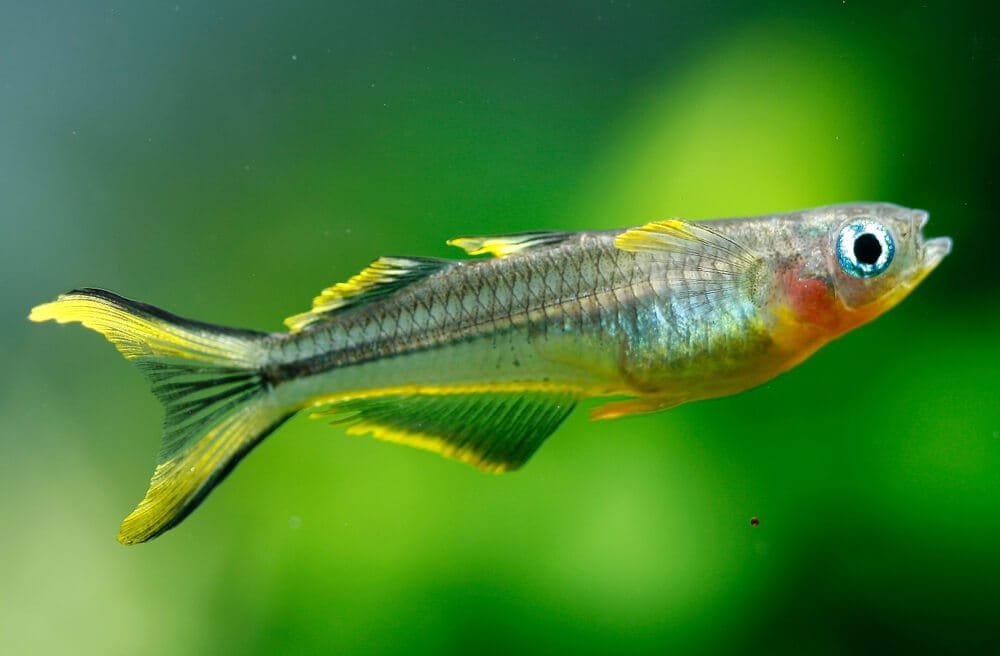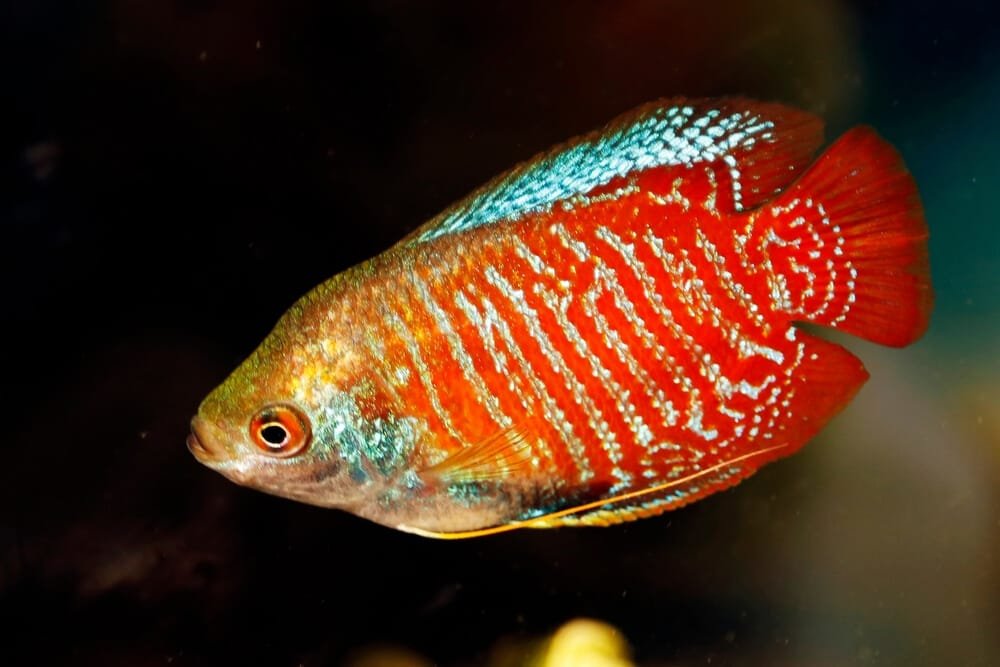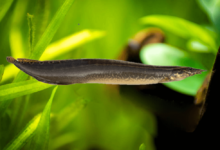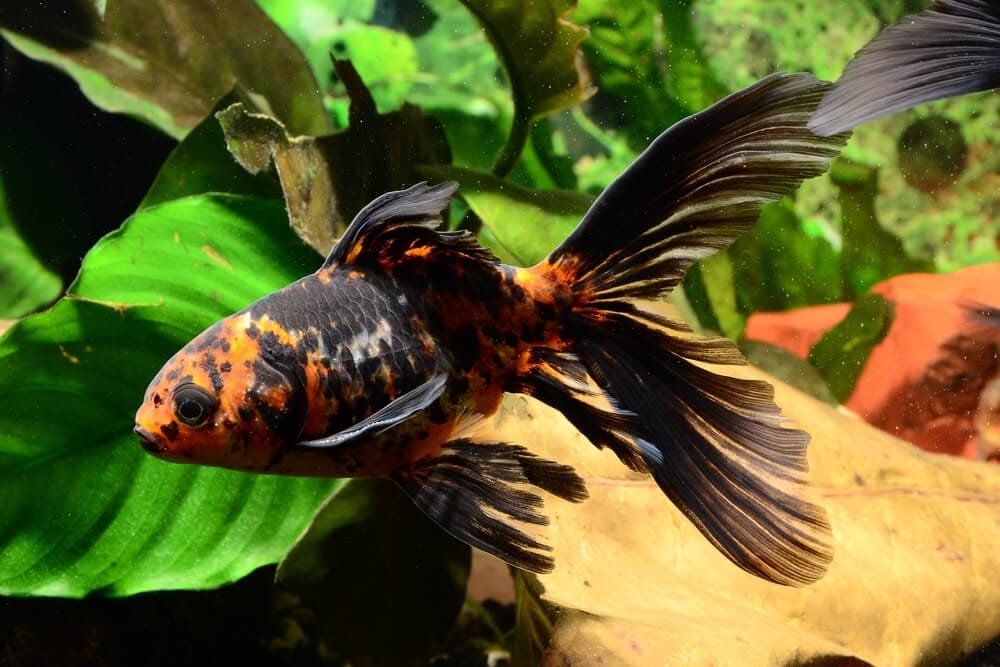Bumblebee Cichlid Tank Mates: How To Choose Them And Top 7 Picks
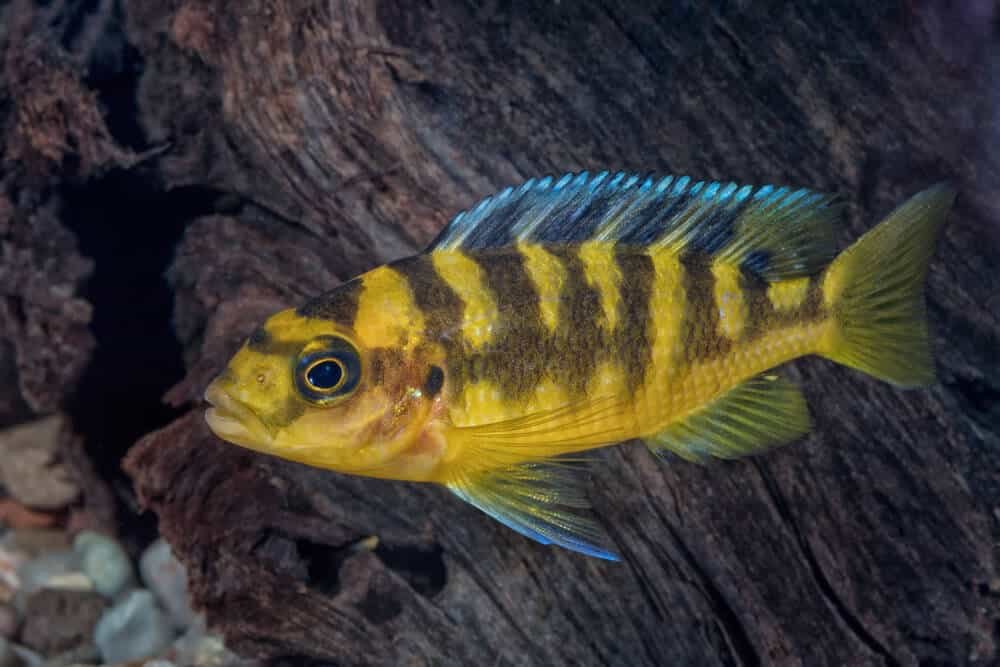
Chances are you’re looking for bumblebee cichlid tank mates, so you’ve reached this post. Before combining the bumblebee cichlids with other fish species, it is important to study your options carefully because not all freshwater aquarium fishes are suitable to add in a bumblebee cichlid tank.
Native to Lake Malawi in Africa, the Bumblebee Cichlids (Pseudotropheus crabro) look like bumblebees, hence the name. Their bodies are golden with black stripes running across their body.
Also called hornet cichlids or chameleon cichlids, bumblebee cichlids may also change their color like chameleons.
We’ll talk more about its personality and temperament and most importantly the best tank mates for your bumblebee cichlids. Keep reading in the following.
Overview Of The Bumblebee Cichlid’s Personality And Behavior
Before setting up a community tank with the bumblebee cichlids on it, you must be careful not to combine them with incompatible species. Otherwise, there will be chaos in the tank and stress to other fishes.
The primary reason for this is the territorial and aggressive behavior of our featured fish. They will pick up a fight with other fishes if they feel threatened. In addition, they can display aggressive behavior when they need to defend their territory.
The males are the most notorious of all. If they obsess over female cichlids, they can be particularly aggressive.
The males also tend to fight with species looking like them, even their own kind. That is why you need to separate the males from other males to reduce fighting. For every male cichlid, there should be three females, preventing the male from harassing the female bumblebee cichlids.
But even if these fishes are aggressive, they can still live with other fishes. However, make sure that you’ll combine them with tank mates native to Lake Malawi as well as those with the same requirements in terms of water parameters.
You should also only combine them with fish species possessing semi-aggressive temperaments. Additionally, it will help to maintain the right tank conditions to reduce and prevent fighting and fin nipping.
Regarding its personality, they seem to be very confident.
Overall, they have a short temper and are very aggressive and tend to pick fights with almost all fishes.
The aggression and short temper can be particularly obvious in the breeding season. Take note of this to prevent chaos in the tank and maintain a peaceful environment for all your fishes.
If you’ll watch their movement, they are slow swimmers, typically in the lower section and around the middle of the aquarium.
What Are Ideal Bumblebee Cichlid Tank Mates?
While you may be thinking of combining your bumblebee cichlid with any fish species out there, you should be careful.
Don’t add tank mates with the same appearance and color as the bumblebee cichlids. Otherwise, they’ll feel threatened and exhibit aggressive behavior.
Don’t also add invertebrates in a tank with bumblebee cichlids. They’re so small that they can be prey for the cichlid.
Generally, these cichlids can live in a community tank, though. However, they don’t make the best tank mates for any fish in a community tank because of their territorial and aggressive personalities.
Instead, they will be happy if kept with similar species. But then, remember to set up your tank with a lot of female bumblebee cichlids because males tend to fight for the attention of the females. I recommend keeping only one male with a few females in the tank.
Keeping similar bumblebee cichlids on their own is a better idea if you want to reduce compatibility issues when looking for bumblebee cichlid tank mates.
They’re also more likely to feed on fish eggs. That’s why they are not a popular choice for combining in a community tank.
They are also quite large, so keeping them in a big tank must be a priority to prevent stress and keep them happy. The tank must be large enough to accommodate not only your bumblebee cichlids but other fishes you wish to keep in the tank.
As much as possible, you should keep them in an African cichlid-only tank. You should not also overcrowd your tank to prevent fights and stressing other fishes in it.
7 Suitable Bumblebee Cichlid Tank Mates
Do not just add bumblebee cichlids into your tank without doing your homework. In the following, we’ve listed some of the most compatible tank mates for this fish.
1. Electric Yellow Labs

The fish is a native to Lake Malawi, living and thriving in larger bodies of water. They love to position their homes in quieter and less busy areas.
They’re some of the most peaceful fish for a pet, and they make for compatible tank mates for bumblebee cichlids.
They are docile among the Mbuna species and are versatile enough to be combined with almost any cichlid setups.
However, they can also become aggressive if you will keep them with fishes of the same build, shape, and color. They dislike looking at fishes that look like them. They’re a freshwater fish distinct for their blue, albino yellow and yellow color.
But unlike their name, they can develop a wide range of morphs, which are dependent on where they come from in Lake Malawi. Commonly, they’re dominant color is blue.
They are semi-aggressive but not territorial. In addition, they are an attractive fish that is also suitable for a beginner. You can consider adding them to your tank for pops of color and making your tank more attractive.
They also have a long lifespan ranging from six to 10 years based on care and water quality when kept in an aquarium.
Overall, the yellow labs are adaptable and versatile to add to any freshwater tank setup. However, make sure to keep them in pairs, if possible, to make them happy.
Aside from the bumblebee cichlids, they’re quite compatible with the same species, tiger Oscar, peacock cichlid, pleco, and convict cichlid.
2. White Tail Aceis
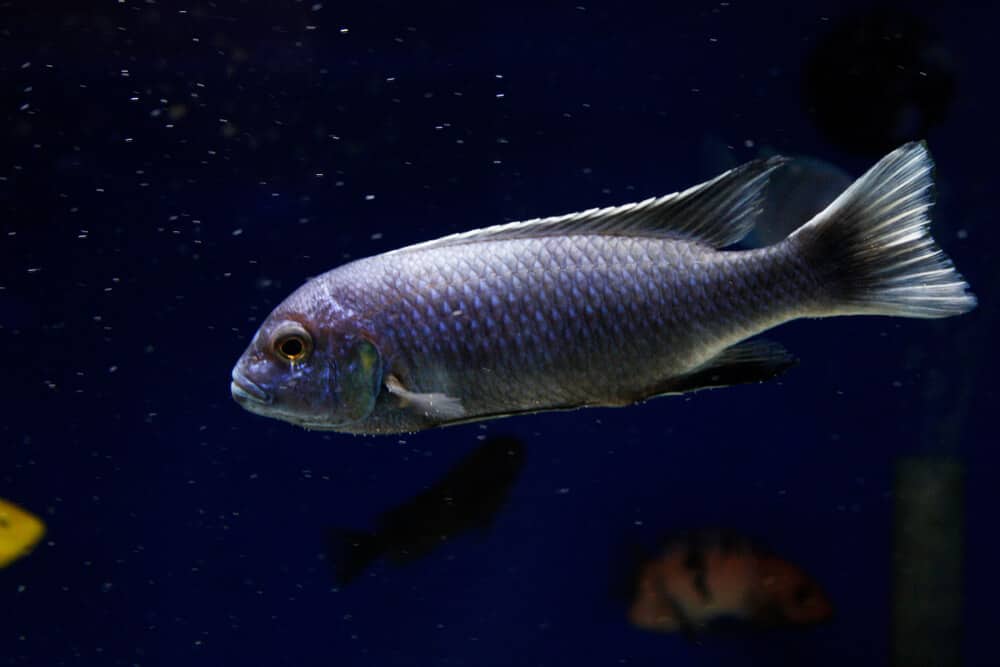
Another compatible tank mate with the bumblebee cichlids is the whitetail aceis or Pseudotropheus, which is a native from Lake Malawi. They belong to the Mbuna group.
Aside from the bumblebee cichlids, they’re also compatible with the Labidochromis caeruleus and other easygoing and friendly Mbuna species as well as Copadichromis and Aulonocara. However, you should avoid combining them with fishes that have a similar color pattern.
The fish has a wide range of personality types from being chill to being aggressive bullies. They sit on the milder side of the Acei cichlid, which is common in the fishkeeping hobby for a long time.
Their morph depends on where they come from and colors can range from a yellow to a white finnage.
The male species are inky black and create a lovely contrast to the white color in their caudal fin. They also have a white margin visible on their pelvic fin and dorsal fin.
They also make a great addition to a common Mbuna aquarium. Many of the species in the group are bottom dwellers and prefer a diet with a lot of vegetable matter. I also recommend this type of diet to avoid digestive issues, including the Malawi bloat.
3. Golden Mbuna
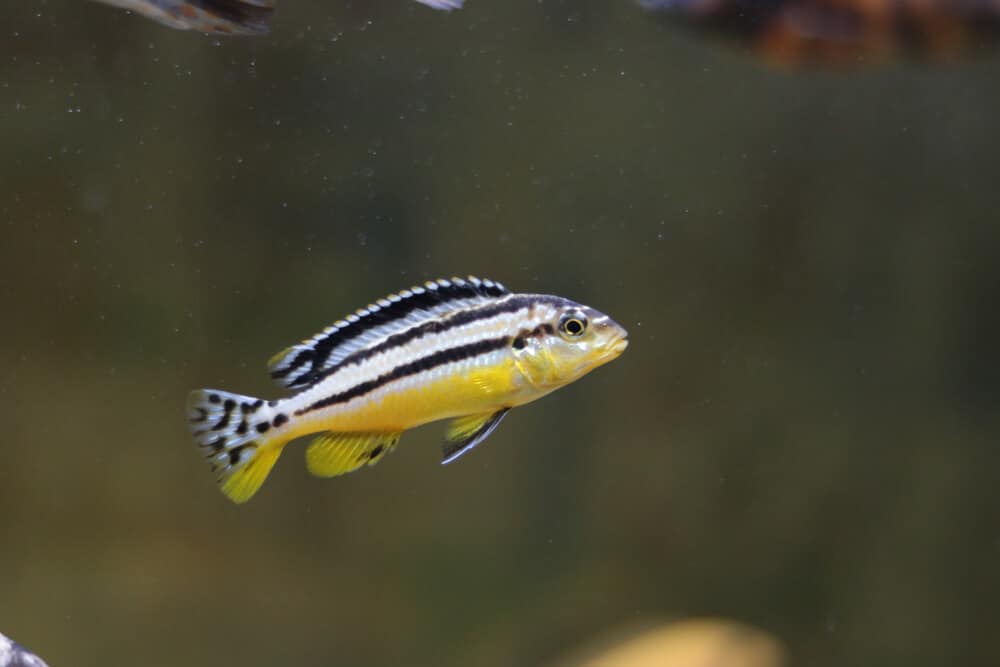
The golden mbuna has spiny rays in the back parts of their dorsal, pectoral, and anal fins, which can help in deterring predators. They also have one nostril on each side of it, but the others have two.
The front portion of their fins is soft, making them ideal for effortless water movement.
Males in general have a golden yellow or light yellow color at the back, while the rest of their body is black.
The females are golden yellow with a black dorsal fin, which is characterized by golden edges. They have a black back and the rest of their body is golden.
This fish is not recommended for beginner aquarists because they tend to be tricky to care for. They are also territorial and aggressive, so they’re not recommended to add to a tank with peaceful and calm species.
In particular, the males are intolerant of other males, especially those that look similar to them. They also exhibit aggressive behavior when combined with other males of their own.
To keep them successfully, you should provide them with a large tank and more hiding place.
They are quite larger than other fishes and can grow up to 11 centimeters in length and can be best kept in tanks with 225 liters of water. This size is for only one male and several females.
They are another compatible fish with the bumblebee cichlids and other species like the rainbow fish that moves fast to distract the male golden Mbuna. It will also help the males to prevent aggression on at least one fish.
The golden mbuna is not advised for keeping in a community fish with other species. However, they can be compatible with cichlids like the bumblebee cichlids. Nevertheless, you should set up your tank only with compatible fishes to prevent aggression and the fish from picking up fights with each other.
4. Red Peacock Cichlids

Among all aquarists, the red peacock cichlids are some of the most popular freshwater fishes. They are astoundingly beautiful, a characteristic that makes them stand out among the rest. In addition, they are easy to care for and maintain.
You’ll be amazed at how this fish looks so lovely with their colors unique to all the fishes you will find among freshwater species.
You’ll have many options when it comes to selecting the tank mates for this fish, which generally possesses a friendly and calm nature. In the cichlid family, they’re the tame member and will work perfectly well with other fishes in the community tank.
Males can be quite territorial, though, but they will do well when with other fishes, such as the bumblebee cichlids, provided you give them enough living space and a lot of hiding places. Doing so will help in reducing their aggressive and territorial quality.
If you would like to combine the peacock cichlids with the bumblebee cichlids, ensure that your tank has ideal water parameters to keep them happy. They are also generally compatible with other non-aggressive types, including the Haplochromis cichlid.
5. Melanochromis Chipokae
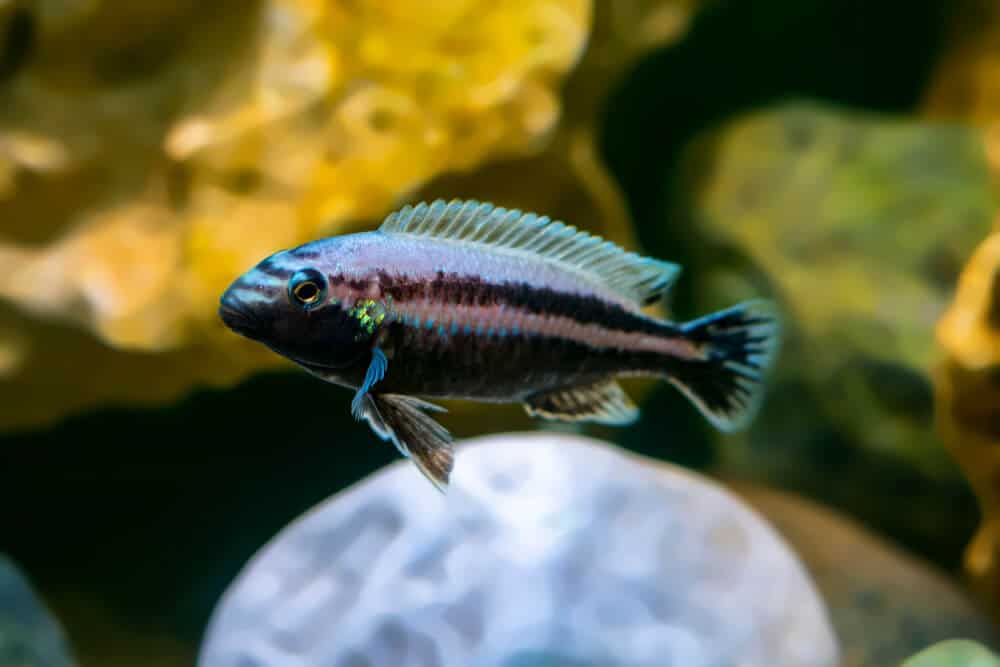
The Melanochromis chipokae is another fish to consider adding with your bumblebee cichlid tank.
Males are easily distinguishable for their dark gray-blue appearance along with electric blue highlights to their flanks. On the other hand, the attractive females typically have an orange tail, yellow belly, brown and tan stripes, which extend into their dorsal fin.
But while the Melanochromis chipokae is compatible with the bumblebee cichlids, they are not recommended for beginners. They are an aggressive fish, although they can stay pretty small, reaching up to six inches when in captivity.
In general, the chipokae can only reach 12 centimeters.
The fish that is also a Lake Malawi native species are only known to exist at the Chipoka, living only in the habitats with patches of sand among the rocks.
In recent years, it has become increasingly popular in the aquarium trade, so its population has been suffering from decline. For this reason, the IUCN has classified it as Critically Endangered.
6. Pseudotropheus Cyaneorhabdos
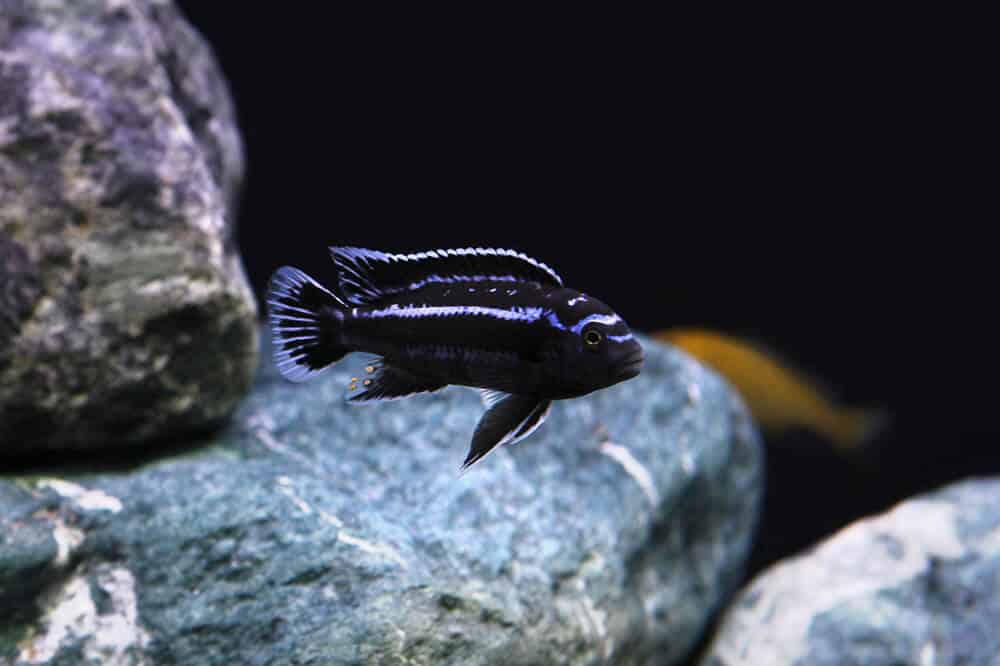
The water chemistry in Tanganyika, Victoria, and Malawi lakes are almost identical.
In this case, you should not have any issues keeping this fish from any of these bodies of water together provided that they have the same personality and temperament.
You can consider this fish for your community tank with the bumblebee cichlids. You can successfully raise and keep the bumblebees with this and other Mbuna fishes.
However, keep in mind that you don’t combine them with similarly colored fishes because they tend to be aggressive towards those that look like them.
To keep the fishes happy with other species in your community tank, be sure to add a lot of escape pathways, plants, and hiding places. Pseudotropheus cyaneorhabdos prefers rocky substrates, too.
Male and female Pseudotropheus cyaneorhabdos are the same in color. But then, males can have a more intense color especially those that are sexually active or dominant. They can grow up to 7.5 centimeters in length.
7. Tanganyika Cichlids
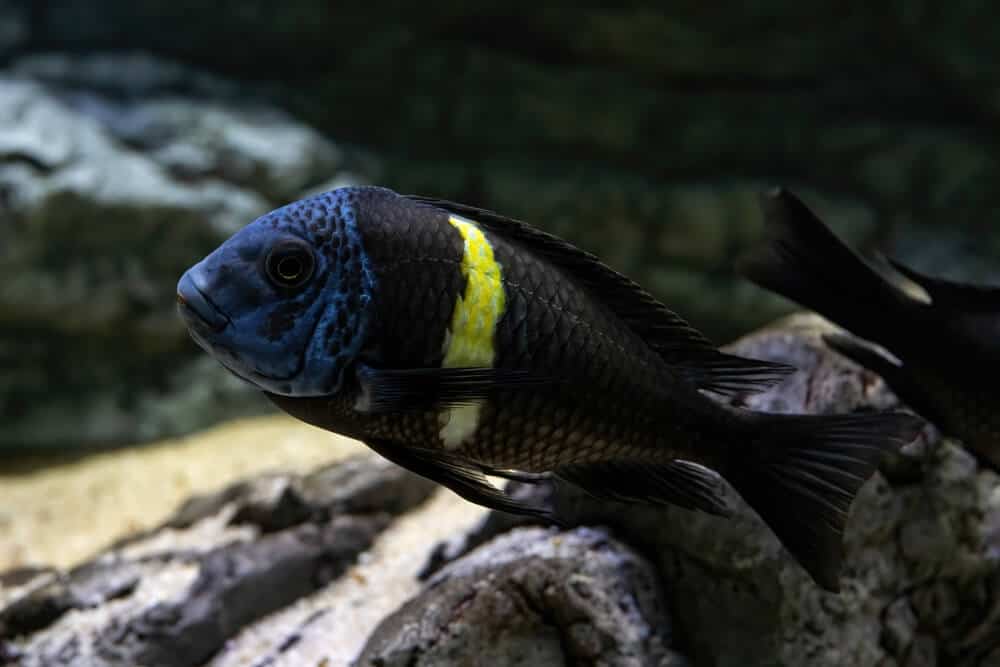
These cichlids are endemic to Lake Tanganyika in Central Africa. It is the second deepest lake in the world and is home to thousands of other fish species. They’ve adapted and adapted to the changing environments of the lake, which is also one of the oldest on the planet.
They are popular among fishkeepers looking for tank mates for their bumblebee cichlids. One of the most known characteristics is their different maximum sizes, although most of them are within two inches and 14 inches in size.
With small or medium-sized cichlids, a tank with a size between 32 inches or 30 gallon tank will be sufficient for a community tank. However, you might need more tank space when you wish to keep different biotypes.
The Tanganyika cichlids are suitable to add in a community tank with a bumblebee cichlid.
They can live well with other fishes that also include different cichlid types, but ensure that they have the same needs and requirements, such as water parameters.
And in most cases, they can be successfully kept with other cichlids endemic from Lake Malawi. Less aggressive types, like those from the genus Aulonocara are ideal, too.
They can also live in peace with rainbowfish, catfish, Tanganyika Spiny Eels, and Tanganyika Killifish.
However, ensure that you combine them with fish of the same size. Also, see to it that you set up your aquarium with areas that are compatible for all types of cichlids.
For example, sand dwellers should be provided with sand areas and snail shells and rock dwellers with caves.
When it comes to temperament, the Tanganyika cichlids can be quite aggressive towards other fish species and towards each other. That’s why it is best to keep bully fishes like it with plenty of small fishes to limit injuries and stress as well as fights.
Incompatible Species With The Bumblebee Cichlids
There are lots of fish species that are not compatible with the bumblebee cichlids, basically the smaller and less aggressive ones. They are more likely to be injured, bullied, or attacked by bumblebee cichlids.
Also, male bumblebee cichlids are not suitable to combine with similar male species because they tend to fight with and kill one another because they compete for the female’s attention.
It is also not advised to keep just one male with one female bumblebee cichlid. Especially when breeding, they tend to be aggressive. You must consider keeping them with several female bumblebee cichlids.
In addition, angelfish should not be added to a tank with the bumblebee cichlids. They will not live peacefully together. The angelfish is less aggressive and more peaceful; thus, they will only feel stressed when added to a community fish tank with the aggressive bumblebee cichlids.
While an angelfish is one of the most popular among freshwater fishes for an aquarium, they’re generally calm, making them less ideal to combine with aggressive types like this featured cichlid
Another fish not to combine with the bumblebee cichlid is the Oscar fish. They don’t have the same water parameter requirements, so they’re likely not to thrive in the tank together. The Oscar is not also an aggressive fish, so they are less likely to enjoy living with the bumblebee cichlid.
Frequently Asked Questions
Why Is My Bumblebee Cichlid Turning Black?
The bumblebee cichlids might be turning black if they’re experiencing stress. That’s why you must keep your pets happy to avoid color discoloration, typically happening when living in a tank with poor water quality. In rare cases, the change in color can be due to genetics, although it’s rare.
Are Bumblebee Cichlids Omnivores?
Yes, they are omnivores because they can eat both meat and plant matter. They can also feed on parasites, fish eggs, and larvae. Give them a combination of these foods for a variety and ensure that they receive adequate nutrition.
Why Are My Cichlids Changing Color?
Your cichlids are changing color likely due to environmental stress. It can be the result of poor water parameters and quality as well as stress from other fishes in the tank.
A change in color happens to nearly all fish species, especially when placed in a stressful environment. It is essential that you keep the water clean and its temperature ideal for the needs of the bumblebee cichlids.
Especially if you want to breed them, ensure that they stay happy and healthy by maintaining suitable environments for them.
How Many Bumblebee Cichlids Can Live Together?
The ideal number of bumblebee cichlids to keep in the tank is one male to six females, preventing the males from harassing a single female. The male bumblebee cichlids can also be quite aggressive when spawning. This sometimes results in the female’s death.
How Do You Tell The Difference Between A Male And Female Bumblebee Cichlid?
To spot the difference between a male and a female bumblebee cichlid, look at their size and color. The male ones are usually darker and larger than the females are. On the other hand, the females have rounder and shorter fins when compared to the males.
The male cichlids also have dark blue stripes, and females have a distinctive zigzag pattern.
Final Thoughts
Choosing the right bumblebee cichlid tank mates will maintain the harmony and peace in your tank. It is why you must do your homework to decide on what to add in a community tank with the bumblebee cichlids. Otherwise, keeping them with incompatible species will just cause stress to the rest of the species in your aquarium.
We’re hoping that you learn a thing or two from this post outlining the top seven picks for compatible tank mates for our featured cichlid.
Also, refer to the fish’s overview if you need more information on their behavior, personality, and temperament, among others.
But if you’ve just started setting up your tank, don’t be in a hurry and take your time. Study your options well and slowly but surely set up your community tank with your bumblebee cichlids.
